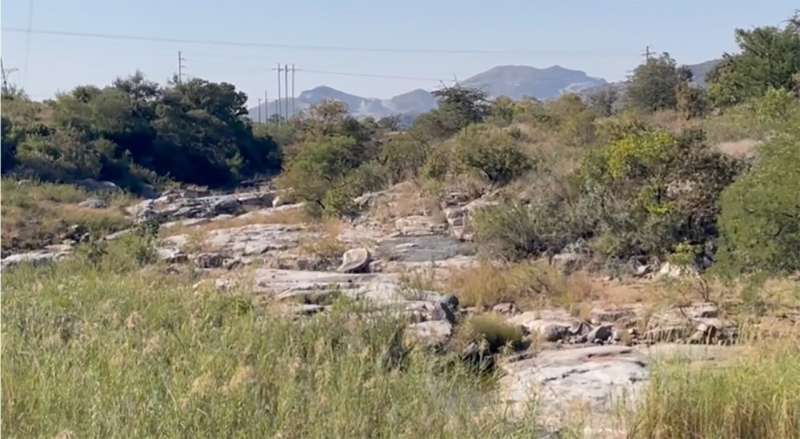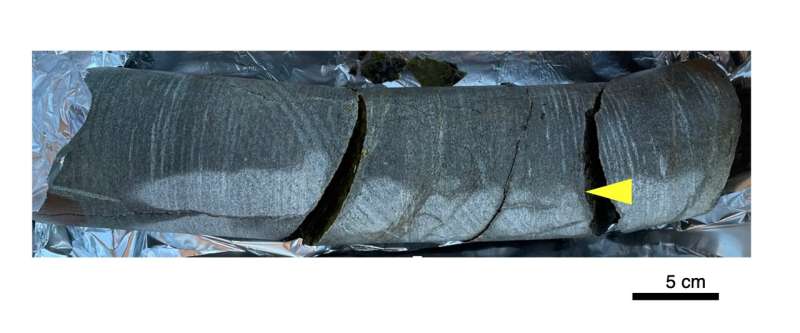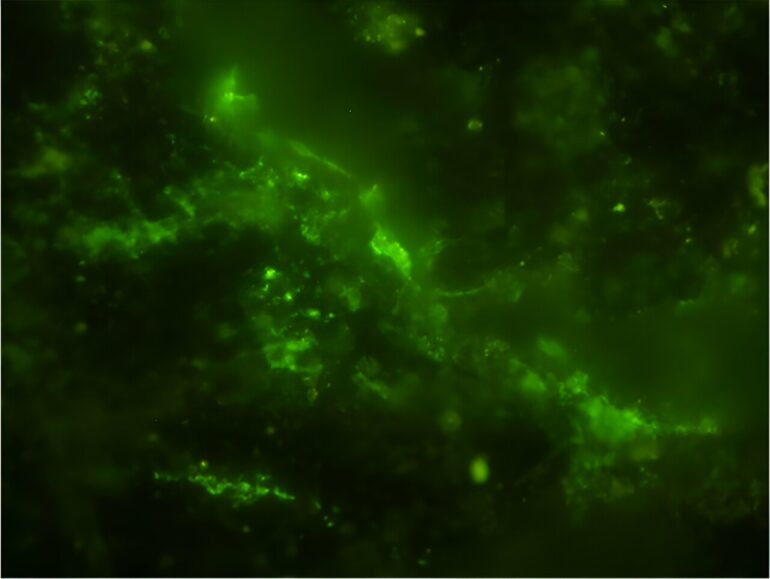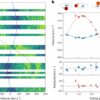Pockets of microbes have been found living within a sealed fracture in a 2-billion-year-old rock. The rock was excavated from the Bushveld Igneous Complex in South Africa, an area known for its rich ore deposits. This is the oldest example of living microbes being found within ancient rock so far discovered.
The team involved in the study built on its previous work to perfect a technique involving three types of imaging—infrared spectroscopy, electron microscopy and fluorescent microscopy—to confirm that the microbes were indigenous to the ancient core sample and not caused by contamination during the retrieval and study process.
The work is published in the journal Microbial Ecology.
Research on these microbes could help us better understand the very early evolution of life, as well as the search for extraterrestrial life in similarly aged rock samples brought back from Mars.
Deep in the Earth lies something ancient and alive. Colonies of microbes live in rocks far beneath the surface, somehow managing to survive for thousands, even millions of years. These tiny, resilient organisms appear to live life at a slower pace, scarcely evolving over geological time spans and so offering us a chance to peek back in time. Now, researchers have found living microbes in a rock sample dated to be 2 billion years old.
“We didn’t know if 2-billion-year-old rocks were habitable. Until now, the oldest geological layer in which living microorganisms had been found was a 100-million-year-old deposit beneath the ocean floor, so this is a very exciting discovery. By studying the DNA and genomes of microbes like these, we may be able to understand the evolution of very early life on Earth,” said Yohey Suzuki, lead author and associate professor from the Graduate School of Science at the University of Tokyo.

The Bushveld Igneous Complex (BIC), South Africa: This picture shows a very famous outcrop where nearly horizontal black and white layers are observed. The BIC made of layers of igneous rock in a basin shape, formed over a period of about 1 million years, after which it seems to have barely changed. © Y. Suzuki/ CC BY NC ND
The rock sample was taken from the Bushveld Igneous Complex (BIC), a rocky intrusion in northeastern South Africa which formed when magma slowly cooled below the Earth’s surface. The BIC covers an area of approximately 66,000 square kilometers (roughly the size of Ireland), varies in thickness by up to 9 km, and contains some of the richest ore deposits on Earth, including about 70% of the world’s mined platinum.
Due to the way it was formed and minimal deformation or change occurring to it since then, the BIC is believed to have provided a stable habitat for ancient microbial life to continue until today.
With the aid of the International Continental Scientific Drilling Program, a nonprofit organization that funds exploration at geological sites, the team obtained a 30-centimeter-long rock core sample from about 15 meters belowground.
The rock was cut into thin slices and analyzed, which is when the team discovered living microbial cells densely packed into cracks in the rock. Any gaps near these cracks were clogged with clay, making it impossible for the organisms to leave or for other things to enter.

Drill core sample with opened fractures: This picture was taken on site when the drill core sample was washed, flamed and then cracked. The 30-centimeter-long, 85-millimeter-diameter core was taken back to Japan for further study. © Y. Suzuki/ CC BY NC ND
The team built on a technique they had previously developed to confirm that the microbes were native to the rock sample, and not due to contamination during the drilling or examination process. By staining the DNA of the microbial cells and using infrared spectroscopy to look at the proteins in the microbes and surrounding clay, the researchers could confirm that the microorganisms were both alive and not contaminated.
“I am very interested in the existence of subsurface microbes not only on Earth, but also the potential to find them on other planets,” said Suzuki.
“While Martian rocks are generally much older (3 billion to 4 billion years old), NASA’s Mars rover Perseverance is currently due to bring back rocks that are a similar age to those we used in this study. Finding microbial life in samples from Earth from 2 billion years ago and being able to accurately confirm their authenticity makes me excited for what we might be able to now find in samples from Mars.”
More information:
Yohey Suzuki et al, Subsurface Microbial Colonization at Mineral-Filled Veins in 2-Billion-Year-Old Mafic Rock from the Bushveld Igneous Complex, South Africa, Microbial Ecology (2024). DOI: 10.1007/s00248-024-02434-8
Provided by
University of Tokyo
Citation:
2-billion-year-old rock could help understand very early life on Earth and the hunt for evidence of life on Mars (2024, October 3)



